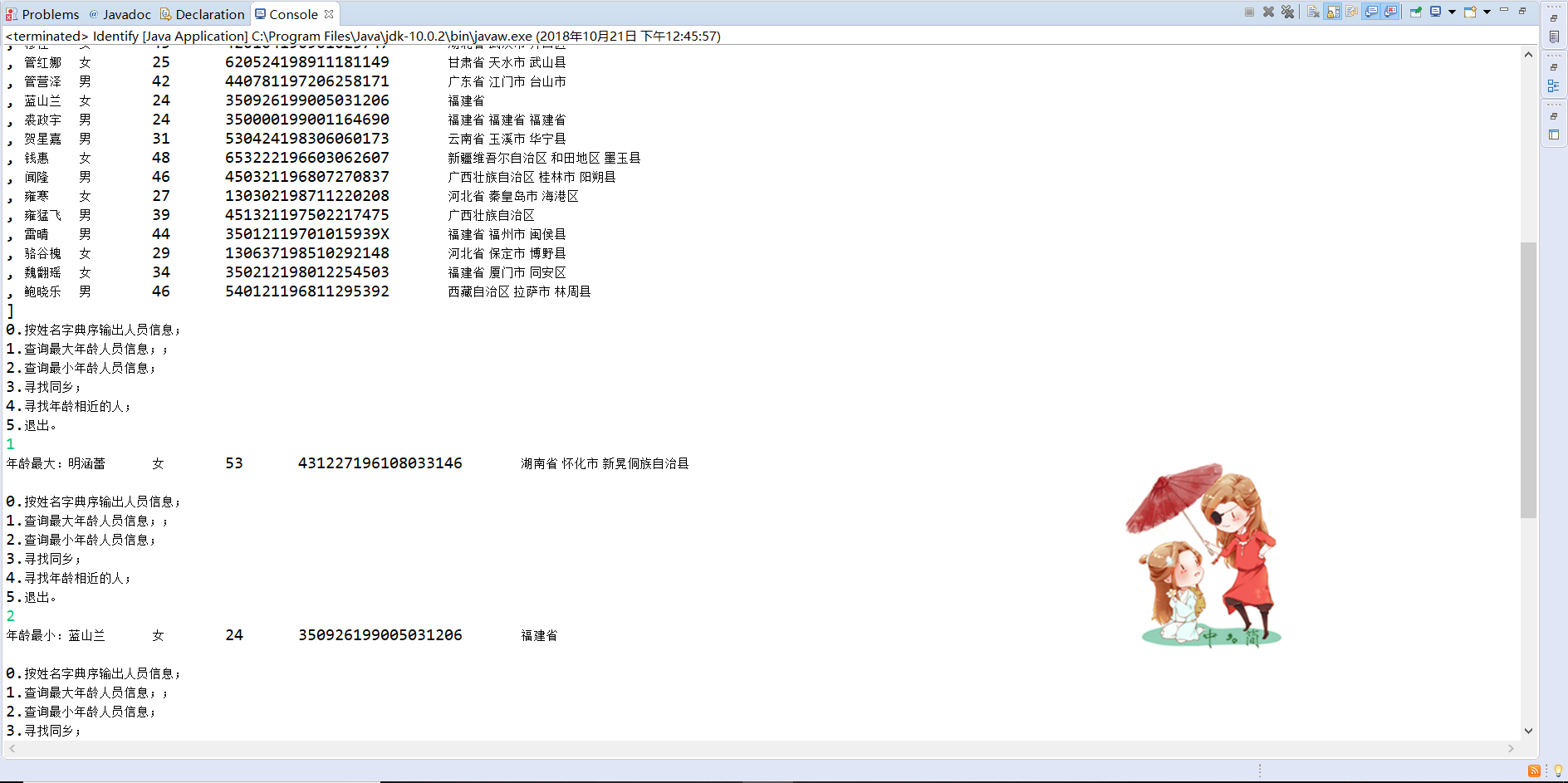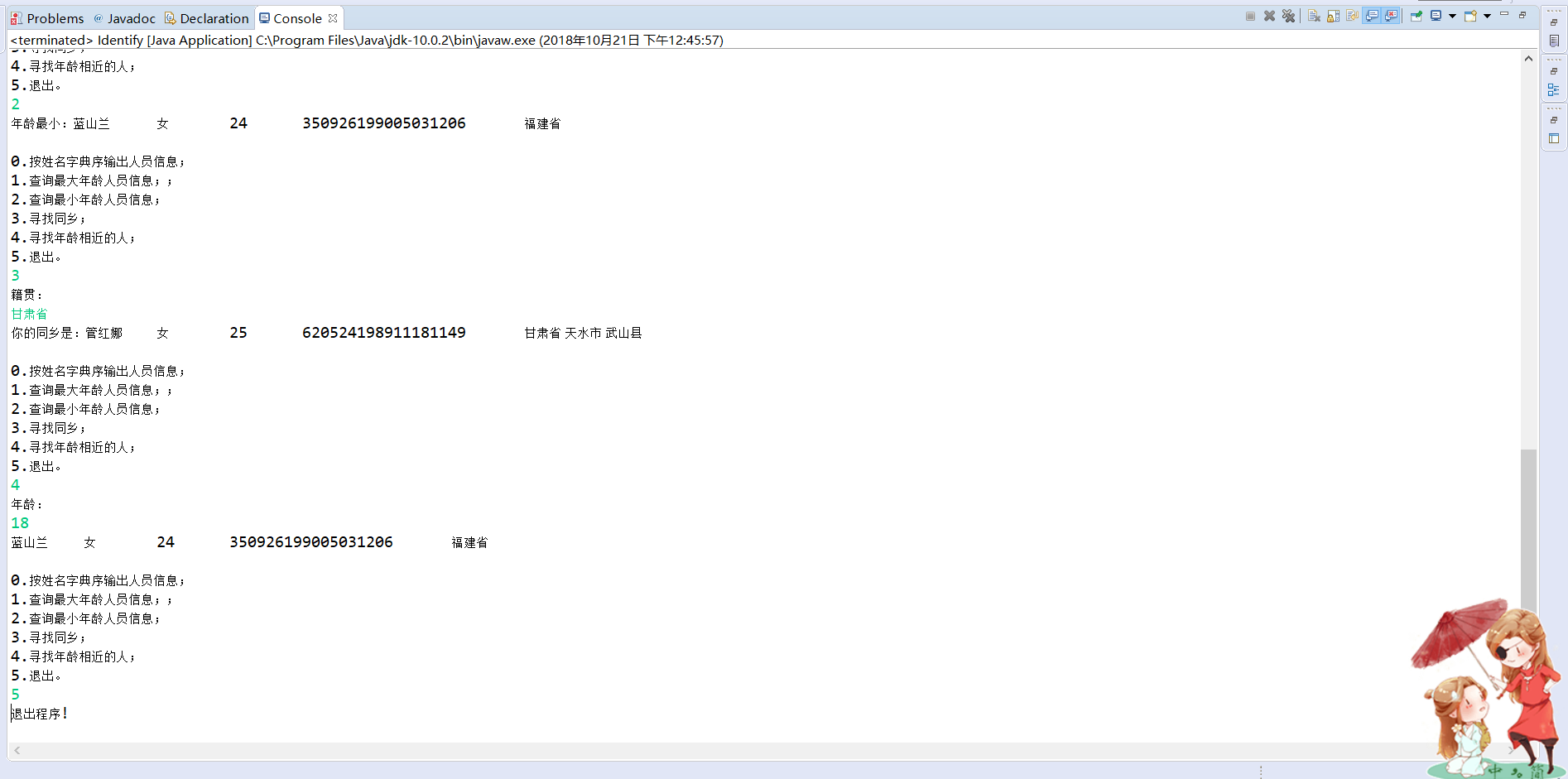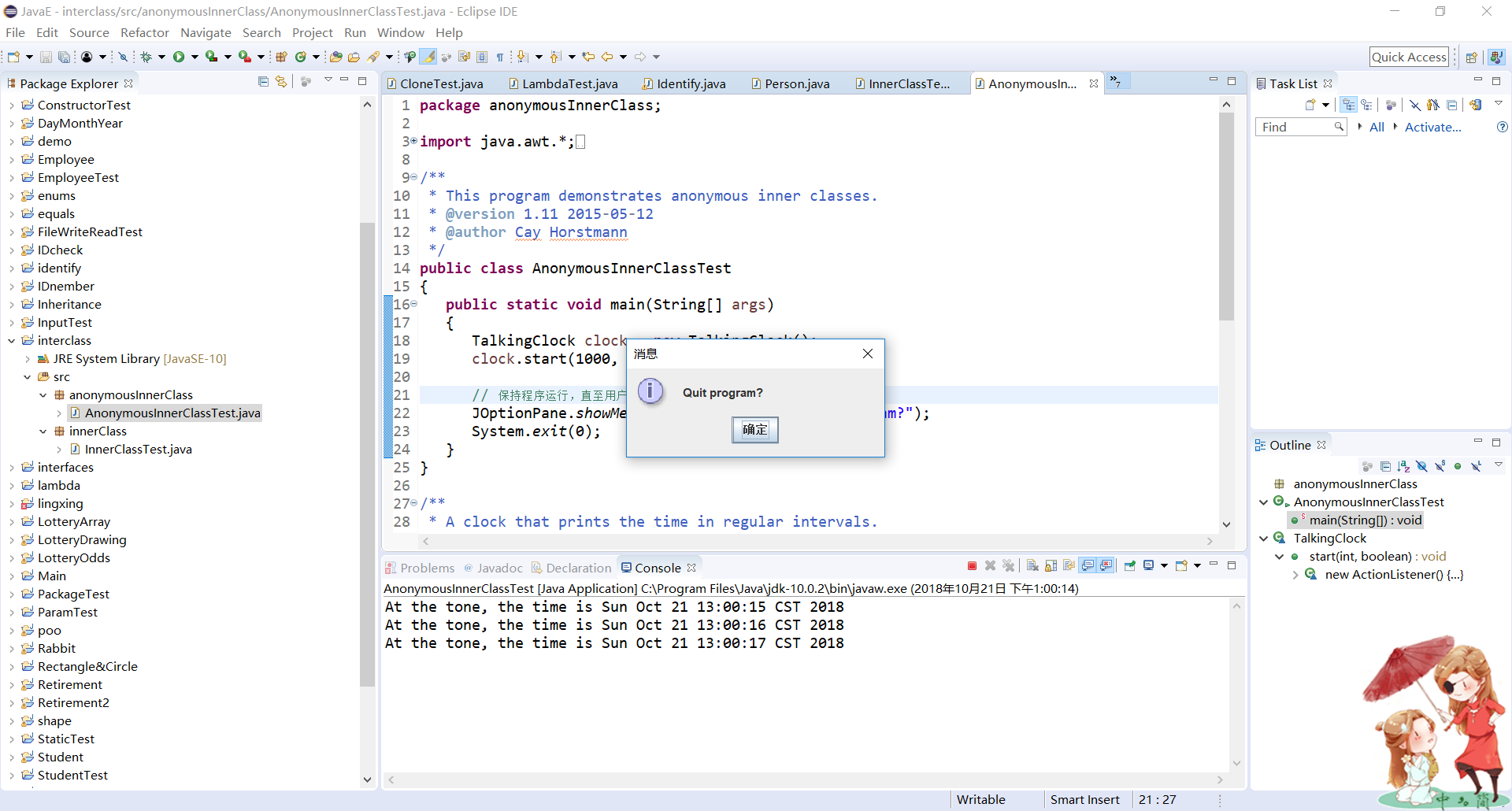理论知识部分:
1.接口:接口不是类,而是对类 的一组需求描述,由常量和一组抽象方法组成。
接口中不包括变量和有具体实现的方法。接口体中包含常量定义和方法定义,接口中只进 行方法的声明。
只要类实现了接口,则该类要遵从接口描述的统 一格式进行定义,并且可以在任何需要该接口的 地方使用这个类的对象。
声明方式:
public interface 接口名
{ …… }
接口以扩展,扩展方法:
public interface 接口1 extends接口2
{ …… }
可以使用extends来继承接口的常量和抽象方 法,扩展形成新的接口;
接口中的所有常量必须是public static final,方法必须是public abstract,这是系统默认的,
在类声明时用implements关键字声明使用一个或 多个接口
class Employee implementsPrintable
{ …… }
一个类使用了某个接口,那么这个类必须实现该 接口的所有方法,为这些方法提供方法体。
一个类可以实现多个接口,接口间应该用逗号分 隔开。 如:class Employee implements Cloneable,Comparable
若实现接口的类不是抽象类,则必须实现所有 接口的所有方法,即为所有的抽象方法定义方 法体。
2.接口的使用:
接口不能构造接口对象,但可以声明接口变量以 指向一个实现了该接口的类对象。
Comparable x= new Employee(…);
可以用instanceof检查对象是否实现了某个接口。
if (anObjectinstanceofComparable)
{ …… }
3.Comparator接口
所在包:java.util.*
Comparator接口定义
public interface Comparator<T>{
int compare(T o1,T o2);
......
}
用途:处理字符串按长度进行排序的操作。
4.Object类的Clone方法
Object类的clone()方法是一个native方法。
Object类中的clone()方法被protected修饰符修饰。
Object.clone()方法返回一个Object对象。
5.浅层拷贝:被拷贝对象的所有常量成员和基本类 型属性都有与原来对象相同的拷贝值,而若成员 域是一个对象,则被拷贝对象该对象域的对象引 用仍然指向原来的对象。
6.深层拷贝:被拷贝对象的所有成员域都含有与原 来对象相同的值,且对象域将指向被复制过的新对 象,而不是原有对象被引用的对象。换言之,深 层拷贝将拷贝对象内引用的对象也拷贝一遍。
7.Lambda表达式本质上是一个匿名方法。 public intadd(intx, inty) { return x + y; } 转成Lambda表达式后是这个样子: (intx, inty) -> x + y;
8.Lambda 表达式的语法基本结构
(arguments) -> body
9.内部类(inner class)是定义在一个类内部的类。
外层的类成为外部类(outer class)。
内部类主要用于事件处理。
内部类的声明格式如下:
[修饰符] class outerClass{
…
[修饰符] class innerClass{
…
}
…
}
实验部分:
实验内容和步骤:
实验1:
测试程序1:
EmployeeSortTest.java
package interfaces;
import java.util.*;
/**
* This program demonstrates the use of the Comparable interface.
* @version 1.30 2004-02-27
* @author Cay Horstmann
*/
public class EmployeeSortTest
{
public static void main(String[] args)
{
Employee[] staff = new Employee[3];
staff[0] = new Employee("Harry Hacker", 35000);
staff[1] = new Employee("Carl Cracker", 75000);
staff[2] = new Employee("Tony Tester", 38000);
Arrays.sort(staff);//静态方法,按工资高低排序
// 打印所有员工信息
for (Employee e : staff)
System.out.println("name=" + e.getName() + ",salary=" + e.getSalary());
}
}
Employee.java
package interfaces;
public class Employee implements Comparable<Employee>
{
private String name;
private double salary;
public Employee(String name, double salary)
{
this.name = name;
this.salary = salary;
}
public String getName()
{
return name;
}
public double getSalary()
{
return salary;
}
public void raiseSalary(double byPercent)
{
double raise = salary * byPercent / 100;
salary += raise;
}
/**
* Compares employees by salary
* @param other another Employee object
* @return a negative value if this employee has a lower salary than
* otherObject, 0 if the salaries are the same, a positive value otherwise
*/
public int compareTo(Employee other)//用雇员对象与other进行比较
{
return Double.compare(salary, other.salary);
}
}
输出结果:

测试程序2:
package demo;
interface A
{
double g=9.8;
void show( );
}
class C implements A
{
public void show( )
{System.out.println("g="+g);}
}
class InterfaceTest
{
public static void main(String[ ] args)
{
A a=new C( );
a.show( );
System.out.println("g="+C.g);
}
}
输出结果:

测试程序3:
package timer;
/**
@version 1.01 2015-05-12
@author Cay Horstmann
*/
import java.awt.*;
import java.awt.event.*;
import java.util.*;
import javax.swing.*;
import javax.swing.Timer;
//消除javax.swing.Timer与java.util.timer之间产生的二义性
public class TimerTest
{
public static void main(String[] args)
{
ActionListener listener = new TimePrinter();
Timer t = new Timer(10000, listener);//构造一个定时器,每1000毫秒通告listener一次
t.start();//启动定时器
JOptionPane.showMessageDialog(null, "Quit program?");//显示一个包含一条消息和OK按钮的对话框
System.exit(0);
}
}
class TimePrinter implements ActionListener//定义实现一个ActionListener接口的类
{
public void actionPerformed(ActionEvent event)
{
System.out.println("At the tone, the time is " + new Date());
Toolkit.getDefaultToolkit().beep();//获得默认工具箱。发出一声响铃
}
}
输出结果:

测试程序4:
CloneTest.java
package clone;
/**
* This program demonstrates cloning.
* @version 1.10 2002-07-01
* @author Cay Horstmann
*/
public class CloneTest
{
public static void main(String[] args)
{
try
{
Employee original = new Employee("John Q. Public", 50000);
original.setHireDay(2000, 1, 1);
Employee copy = original.clone();
copy.raiseSalary(10);
copy.setHireDay(2002, 12, 31);
System.out.println("original=" + original);
System.out.println("copy=" + copy);
}
catch (CloneNotSupportedException e)
{
e.printStackTrace();
}
}
}
Employee.java
package clone;
import java.util.Date;
import java.util.GregorianCalendar;
public class Employee implements Cloneable
{
private String name;
private double salary;
private Date hireDay;
public Employee(String name, double salary)
{
this.name = name;
this.salary = salary;
hireDay = new Date();
}
public Employee clone() throws CloneNotSupportedException
{
// Object类对象的clone方法
Employee cloned = (Employee) super.clone();
// clone mutable fields
cloned.hireDay = (Date) hireDay.clone();
return cloned;
}
/**
* Set the hire day to a given date.
* @param year the year of the hire day
* @param month the month of the hire day
* @param day the day of the hire day
*/
public void setHireDay(int year, int month, int day)
{
Date newHireDay = new GregorianCalendar(year, month - 1, day).getTime();
// Example of instance field mutation
hireDay.setTime(newHireDay.getTime());
}
public void raiseSalary(double byPercent)
{
double raise = salary * byPercent / 100;
salary += raise;
}
public String toString()
{
return "Employee[name=" + name + ",salary=" + salary + ",hireDay=" + hireDay + "]";
}
}
输出结果:

测试程序4:
package lambda;
import java.util.*;
import javax.swing.*;
import javax.swing.Timer;
/**
* This program demonstrates the use of lambda expressions.
* @version 1.0 2015-05-12
* @author Cay Horstmann
*/
public class LambdaTest
{
public static void main(String[] args)
{
String[] planets = new String[] { "Mercury", "Venus", "Earth", "Mars",
"Jupiter", "Saturn", "Uranus", "Neptune" };
System.out.println(Arrays.toString(planets));
System.out.println("Sorted in dictionary order:");
Arrays.sort(planets);
System.out.println(Arrays.toString(planets));
System.out.println("Sorted by length:");
Arrays.sort(planets, (first, second) -> first.length() - second.length());
System.out.println(Arrays.toString(planets));
Timer t = new Timer(1000, event ->
System.out.println("The time is " + new Date()));
t.start();
// 保持程序运行,直至用户选择OK
JOptionPane.showMessageDialog(null, "Quit program?");
System.exit(0);
}
}

实验3: 编程练习
Identify.java:
package 第八周实验;
import java.io.BufferedReader;
import java.io.File;
import java.io.FileInputStream;
import java.io.FileNotFoundException;
import java.io.IOException;
import java.io.InputStreamReader;
import java.util.ArrayList;
import java.util.Arrays;
import java.util.Collections;
import java.util.Scanner;
public class Identify {
private static ArrayList<Person> personlist;
public static void main(String[] args) {
personlist = new ArrayList<>();
Scanner scanner = new Scanner(System.in);
File file = new File("E:\身份证号.txt");
try {
FileInputStream fis = new FileInputStream(file);
BufferedReader in = new BufferedReader(new InputStreamReader(fis));
String temp = null;
while ((temp = in.readLine()) != null) {
Scanner linescanner = new Scanner(temp);
linescanner.useDelimiter(" ");
String name = linescanner.next();
String number = linescanner.next();
String sex = linescanner.next();
String age = linescanner.next();
String hometown = linescanner.nextLine();
Person person = new Person();
person.setName(name);
person.setnumber(number);
person.setsex(sex);
int A = Integer.parseInt(age);
person.setage(A);
person.sethometown(hometown);
personlist.add(person);
}
} catch (FileNotFoundException e) {
System.out.println("身份信息文件找不到");
e.printStackTrace();
} catch (IOException e) {
System.out.println("身份信息文件读取错误");
e.printStackTrace();
}
boolean isTrue = true;
while (isTrue) {
System.out.println("0.按姓名字典序输出人员信息;");
System.out.println("1.查询最大年龄人员信息;;");
System.out.println("2.查询最小年龄人员信息;");
System.out.println("3.寻找同乡;");
System.out.println("4.寻找年龄相近的人;");
System.out.println("5.退出。");
String W = scanner.next();
switch (W) {
case "0":
Collections.sort(personlist);
System.out.println(personlist.toString());
break;
case "1":
int a = 0;
int j, c1 = 0, d1 = 0;
for (int i = 1; i < personlist.size(); i++) {
j = personlist.get(i).getage();
if (j > a) {
a = j;
c1 = i;
}
}
System.out.println("年龄最大:" + personlist.get(c1));
break;
case "2":
int b = 100;
int c2 = 0,d2 = 0;
for (int i = 1; i < personlist.size(); i++) {
j = personlist.get(i).getage();
if (j < b) {
b = j;
d2 = i;
}
}
System.out.println("年龄最小:" + personlist.get(d2));
break;
case "3":
System.out.println("籍贯:");
String search = scanner.next();
String place = search.substring(0, 3);
int i = 0;
for (; i < personlist.size(); i++) {
if (personlist.get(i).gethometown().substring(1, 4).equals(place))
System.out.println("你的同乡是:" + personlist.get(i));
}
break;
case "4":
System.out.println("年龄:");
int yourage = scanner.nextInt();
int nearaga = agenear(yourage);
int value = yourage - personlist.get(nearaga).getage();
System.out.println("" + personlist.get(nearaga));
break;
case "5":
isTrue = false;
System.out.println("退出程序!");
break;
default:
System.out.println("检查输入!");
}
}
}
public static int agenear(int age) {
int j = 0, b = 53, value = 0, c = 0;
for (int i = 0; i < personlist.size(); i++) {
value = personlist.get(i).getage() - age;
if (value < 0)
value = -value;
if (value < b) {
b = value;
c = i;
}
}
return c;
}
}
Person.java
package 第八周实验;
public class Person implements Comparable<Person> {
private String name;
private String number ;
private String sex ;
private int age;
private String hometown;
public String getName() {
return name;
}
public void setName(String name) {
this.name = name;
}
public String getnumber() {
return number;
}
public void setnumber(String number) {
this.number = number;
}
public String getsex() {
return sex ;
}
public void setsex(String sex ) {
this.sex =sex ;
}
public int getage() {
return age;
}
public void setage(int age) {
this.age= age;
}
public String gethometown() {
return hometown;
}
public void sethometown(String hometown) {
this.hometown=hometown ;
}
public int compareTo(Person o) {
return this.name.compareTo(o.getName());
}
public String toString() {
return name+" "+sex+" "+age+" "+number+" "+hometown+"
";
}
}
输出结果:



实验4:
实验程序1:
package innerClass;
import java.awt.*;
import java.awt.event.*;
import java.util.*;
import javax.swing.*;
import javax.swing.Timer;
/**
* This program demonstrates the use of inner classes.
* @version 1.11 2015-05-12
* @author Cay Horstmann
*/
public class InnerClassTest
{
public static void main(String[] args)
{
TalkingClock clock = new TalkingClock(1000, true);
clock.start();
// 保持程序运行,直至用户选择"Ok"
JOptionPane.showMessageDialog(null, "Quit program?");
System.exit(0);
}
}
/**
* A clock that prints the time in regular intervals.
*/
class TalkingClock
{
private int interval;
private boolean beep;
/**
* Constructs a talking clock
* @param interval the interval between messages (in milliseconds)
* @param beep true if the clock should beep
*/
public TalkingClock(int interval, boolean beep)
{
this.interval = interval;
this.beep = beep;
}
/**
* Starts the clock.
*/
public void start()
{
ActionListener listener = new TimePrinter();
Timer t = new Timer(interval, listener);
t.start();
}
public class TimePrinter implements ActionListener
{
public void actionPerformed(ActionEvent event)
{
System.out.println("At the tone, the time is " + new Date());
if (beep) Toolkit.getDefaultToolkit().beep();
}
}
}
InnerClassTest
输出结果:

实验程序2:
package anonymousInnerClass;
import java.awt.*;
import java.awt.event.*;
import java.util.*;
import javax.swing.*;
import javax.swing.Timer;
/**
* This program demonstrates anonymous inner classes.
* @version 1.11 2015-05-12
* @author Cay Horstmann
*/
public class AnonymousInnerClassTest
{
public static void main(String[] args)
{
TalkingClock clock = new TalkingClock();
clock.start(1000, true);
// 保持程序运行,直至用户选择"Ok"
JOptionPane.showMessageDialog(null, "Quit program?");
System.exit(0);
}
}
/**
* A clock that prints the time in regular intervals.
*/
class TalkingClock
{
/**
* Starts the clock.
* @param interval the interval between messages (in milliseconds)
* @param beep true if the clock should beep
*/
public void start(int interval, boolean beep)
{
ActionListener listener = new ActionListener()
{
public void actionPerformed(ActionEvent event)
{
System.out.println("At the tone, the time is " + new Date());
if (beep) Toolkit.getDefaultToolkit().beep();
}
};
Timer t = new Timer(interval, listener);
t.start();
}
}
输出结果:

实验程序3:
package staticInnerClass;
/**
* This program demonstrates the use of static inner classes.
* @version 1.02 2015-05-12
* @author Cay Horstmann
*/
public class StaticInnerClassTest
{
public static void main(String[] args)
{
double[] d = new double[20];
for (int i = 0; i < d.length; i++)
d[i] = 100 * Math.random();
ArrayAlg.Pair p = ArrayAlg.minmax(d);
System.out.println("min = " + p.getFirst());
System.out.println("max = " + p.getSecond());
}
}
class ArrayAlg
{
/**
* A pair of floating-point numbers
*/
public static class Pair
{
private double first;
private double second;
/**
* Constructs a pair from two floating-point numbers
* @param f the first number
* @param s the second number
*/
public Pair(double f, double s)
{
first = f;
second = s;
}
/**
* Returns the first number of the pair
* @return the first number
*/
public double getFirst()
{
return first;
}
/**
* Returns the second number of the pair
* @return the second number
*/
public double getSecond()
{
return second;
}
}
/**
* Computes both the minimum and the maximum of an array
* @param values an array of floating-point numbers
* @return a pair whose first element is the minimum and whose second element
* is the maximum
*/
public static Pair minmax(double[] values)
{
double min = Double.POSITIVE_INFINITY;
double max = Double.NEGATIVE_INFINITY;
for (double v : values)
{
if (min > v) min = v;
if (max < v) max = v;
}
return new Pair(min, max);
}
}
输出结果:

总结:
接口与抽象类的区别有:
接口不能实现任何方法,而抽象类可以。类可以实现许多接口,但只有一个父类。接口不是类分级结构的一部分,无任何联系的类可以实现相同的接口。抽象类是用abstract来声明,没有具体实例对象的类,不 能用new来创建对象。可包含常规类所包含的任何东西。 抽象类必须由子类继承,如果abstract类的子类不是抽 象类,那么子类必须重写父类中所有的abstract方法。接口是用interface声明,是抽象方法和常量值定义的集 合。从本质上讲,接口是一种特殊的抽象类,这种抽象 类中只包含常量和方法的定义,而没有变量和方法的定义。接口中只能定义抽象方法,而且这些方法默认为是public的。只要类实现了接口,就可以在任何需要该接口的地方使用这个类的对象。
拷贝和克隆:
拷贝:当拷贝一个变量时,原始变量与拷贝变量引用的是同一个对象。当改变一个变量所引用的对象,则会对另一个变量造成影响。
克隆:当克隆一个对象时,是重新的创建了和该对象内容相同的对象。在对象中如果包含了子对象的引用,拷贝的结果就会使得两个域引用同一个子对象,此时,原始对象和克隆对象将共享这一部分信息。这样,当克隆对象改变这部分时,就会造成原始对象中数据的改变。
我还学习到,在理解一些知识点时,可以通过设计测试程序来帮助自己理解,虽然我对于自己设计测试程序还没有掌握,但是我会向助教老师学习这种良好的习惯。